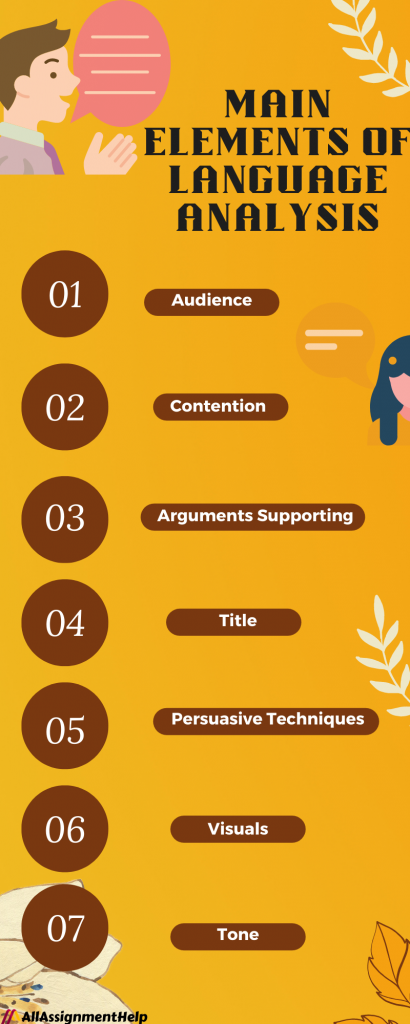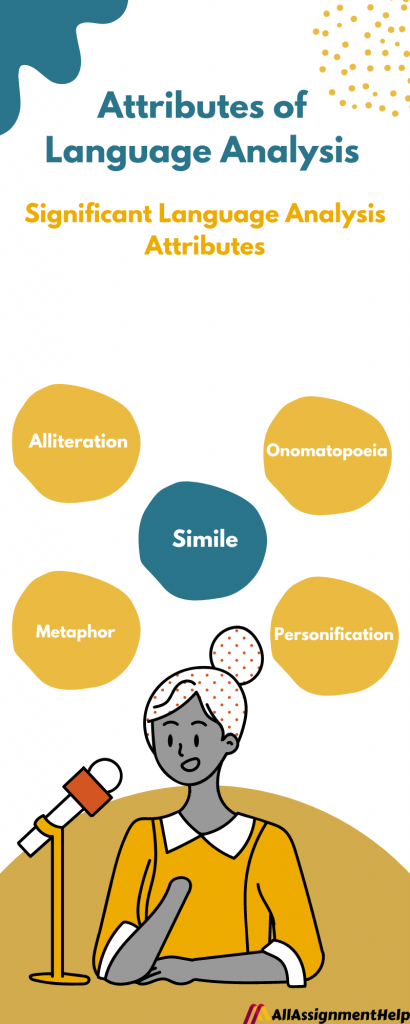Hello to everyone out there reading this blog. I hope you are doing fine and safe and sound. Well! In today’s blog, I will talk about language analysis. Let me tell you that whenever you are writing an essay, article, or another type of project, language is a climacteric component. Remember that your dialect reveals all about your writing style and level of writing expertise. So, my buddy, keep reading if you’re interested in learning how to analyse language. I’ll discuss anything, from the viewpoints of authors and analysts.
The following topics will be primarily covered in this blog by allassignmenthelp.com:
- Exemplifying Language Analysis
- Elements in Language analysis
- Language analysis features.
- Language analysis techniques.
So, guys let’s get started with our topic of the day!
Exemplifying Language Analysis
To grasp what a writer is saying in a piece of writing, such as an essay or an article, is what language analysis simply means. Analysis refers to how a writer is expressing his views through linguistic devices, such as word choice, tone, sentence structure, and figures of speech. What you refer to as “Language Analysis” is the study of language. You must carefully read the article, essay, or other content you are working with in order to recognise each of its parts. An assignment requiring language analysis can be given to you. So don’t worry; I’ll cover every facet of language in this essay to make it easier for you to understand what’s going on.
Elements in Language Analysis
Language analysis examines how authors and writers use particular language devices, like figures of speech, word choice, sentence structure, and registers or tone, to communicate meaning.
Now let’s explore the elements.
Basic Elements of Language Analysis Identified While Writing
Author
- Identify the author of that writing article first. Learn more about the author.
- My opinion is that we also grow curious about the author of the essay.
- Therefore, you write down the author’s name before continuing with the analysis.
- It occasionally also conveys a mental image.
Text Type
- You should be aware of the type of writing you are about to examine.
- Is it an editorial, a letter, a speech, or a column of opinion?
Publication
- Verify the source of the article’s publication.
- Check the publication back and forth.
Also Read: Informative Speech Topics: Guide of Great Ideas
Main Elements of Language Analysis

Audience
- You must determine for what kind of readership that article will be released.
- What will the reader’s response be after reading it?
- Is the article interesting enough?
- You must verify everything.
Contention
It refers to the primary viewpoint the author is attempting to communicate in his writing.
Arguments Supporting Contention
- Determine whether the justifications offered are false or true.
- An Author may make use of either.
- Arguments affect a piece of writing’s thesis.
Title
- It is the most crucial section of a report.
- The public has a bias in favour of winning championships.
- However, the titles must be pertinent to the content.
- You must evaluate how compelling and interesting the title is.
Persuasive Techniques
- Discover the author’s persuasive strategies that he used in his writing.
- Find out if those techniques are employed consistently throughout the article or only in specific areas.
Visuals
- It is imperative to use images, films, or other visual materials to highlight the points you make in your writing.
- You must now determine whether or not the author’s argument is supported by the visuals.
- An excellent article will always have powerful, complementary images to enhance its text.
Tone
- It is the mindset of the author that comes through in his writing.
- Throughout the article, the tone could shift or stay the same.
- The usage of grammar, point of view, diction, and degree of formality in the writing all convey the tone.
- Therefore, you should assess the author’s tone.
Attributes of Language Analysis
You need to be aware of the writing style before you begin to analyse a piece of writing. It means that in order to do an effective language analysis, you must first recognise the various language strategies, and you must do it with some degree of proficiency.
Significant Language Analysis Attributes
While examining the article you have, you may notice the following significant linguistic attributes:

Alliteration
- Alliteration is the usage of words with the same letter and sound at the beginning of their speech, such as “Betty bought better butter.”
- Making a string of words that all begin with the same consonant is a literary device.
- There shouldn’t be any strong usage of alliteration throughout the entire article because it can sometimes obscure the writing or lead you astray.
Simile
- The use of similes in the article is a key aspect of language analysis.
- A simile refers to a comparison between two things.
- He moved as quickly as a cheetah on the ground, for instance.
- The individual is now being compared to a swift Cheetah because he might be moving too quickly.
- As a result, a simile was used to equate the man to a cheetah.
Onomatopoeia
- Literally, it means “the noise I create.”
- What I’m trying to explain is that terms like “splash, spray, sprinkle, drizzle, bang,” etc., are examples of onomatopoeia.
- When we pronounce these words, we can readily sense the sound.
- For instance, “He slammed the door and walked out.” Banging here indicated that the door had been shut very forcefully.
- These words thereby inform us about the activity taking place at that precise moment.
- We are good at visualising.
Metaphor
- It is once more a fascinating aspect of language study.
- Metaphors are expressions that relate one circumstance to another.
- It’s somewhat of an oblique comparison.
- Metaphor demonstrates how one item is similar to another.
- “This chick is on fire,” for instance. Now, this metaphor does not imply that the girl has been burned, but rather that she is excelling in some endeavour.
Personification
- A non-human object is compared to humans in this comparison.
- The final piece of the blueberry cheesecake, for instance, shouted my name. Therefore, although blueberry cheesecake is not a person calling to me, I have personified it such that it sounds as though it is. That implies I desperately want to taste that delicious cake.
These were the five key linguistic strategies that you should be aware of when examining written work. Well! you can also learn about Language Techniques to Improve Your Writing Skills. You must recognise these linguistic devices, evaluate them, and then compose a language analysis.
Let’s now discuss the other components of language analysis.
Language Analysis Attributes For Writing Perfect Content
Vocabulary
- You must determine what terminology the author uses and why in his writing.
- Therefore, you must also comprehend the wordplay the author is using.
- A poet may employ words exactly as they sound or in a novel way (assonance), toying with the word’s beginning letters. This is for many impacts mentioned in the blog.
- When they wish to represent an emergency, such as running or something else, writers may employ verbs that show motion.
- To add interest to his writing, an author may also utilise figurative language and location names.
Syntax
Pay close attention to the punctuation and sentence structure that authors utilise. They are either applied in a typical way or a peculiar way. This tactic is employed to produce impacts at various places in a poem or book.
The author might employ the following literary devices:
- There is no punctuation used.
- Heavy or Terse phrases with punctuation
- The writer could employ straightforward and folktale narrative syntax.
- Lines that are too long and lack punctuation.
Perspective
- You should look at the author’s point of view when reading his text.
- He could be addressing you in the second or third person when he speaks.
- You need to figure out what he is trying to represent.
- What viewpoint is the poet or author attempting to present?
Grammar
- Sometimes writers make grammatical errors, but this isn’t because they’re bad at it; rather, they do it on purpose.
- It’s because each writer has their own writing style and is free to choose how to utilise words in their writing.
- You need to determine whether the author intentionally used poor grammar or if it was a mistake.
- Try to keep in mind the rhetorical consequences as well as the impacts of the tenses.
Imagery
- You must ascertain the type of impression the author hopes to convey through his work.
- Things can also be connected through language.
- The writing may use a variety of colours, each of which stands for something.
- Nature, the terrain, and geography are next.
- You must be certain of the writer’s emotions.
- Pay close attention to the writer’s examples.
- The reader is more strongly affected by this.
Also Read: A Brief Guide to Language Techniques
Useful Clues of Language Analysis to blow Away Your Mind
The ability to analyse language is really helpful. It’s essential to succeed in many academic and collegiate courses. A language analysis report written well reveals a lot about the author. These reports give the reader a thorough analysis.
Let’s now discuss the methods utilised in language analysis:
To Recognize the Format
- You must first comprehend the goal of language analysis.
- Once you comprehend the necessity, you are prepared to proceed.
- You must now comprehend how language analysis is done.
- You need to familiarise yourself with the various rhetorical strategies and persuasion tactics employed by writers.
- The next step is to comprehend what language analysis hopes to achieve.
We now know how language analysis is conducted. Let’s get going.
Let’s Mutilate Further
- Read the available content.
- Make thorough notes as you read.
- Perform a quick scan before diving into the details.
- You can do a thorough analysis with this assistance.
- Highlight or underline important passages.
- You will be able to identify the elements you wish to use with the aid of this.
- Well! you can also opt for an online assignment service if you get stuck anywhere.
- Highlighting the portions and making notes is what will make things easy for you.
- Identify, what is the strong intention of the author.
- This will assist you in structuring your ideas and developing your analyses.
Pin-Point Rhetorical Language Use
- Recognize this circumstance.
- It is crucial that you comprehend every aspect of the current scenario that surrounds the material you are analysing.
- Pay attention to the language you use.
- See what each word means.
- Suppose the author states that it “ended.” This word denotes the end or completion of something. You must research the true meaning of the word utilised.
- Take the writer’s points in the text you have to heart.
See the text for logical implementations. - You can better comprehend the author’s style thanks to that.
Analyze the metaphors. - Metaphors are a topic I’ve already covered in the language analysis features section.
- Create analogies. These are analogies made between two objects with the goal of assisting the reader in comprehending a circumstance or an occurrence.
Finalize Your Analysis in Writing
- Complete your thesis statement.
- Avoid using the usual three-part thesis that is typically taught to beginning writers.
- Create a succinct thesis introduction.
- A strong start is provided by a strong introduction.
- Write the paper’s body next.
- Only include details that help to prove your point.
- Try to speak in detail and with several, distinct points.
- Write a conclusion that restates your thesis before you finish.
Refine and Add the Finishing Touches
- Read the entire language analysis essay.
- Make a compelling title for your article.
- Make two rounds of revisions to ensure there are no flaws in your essay.
- Verify your grammar.
- Lastly, look for formatting or quotation incorporation issues.
Final Thoughts!
We have therefore reached a conclusion. Simply pay attention and note the writing style of the author whose material you must study. You are prepared to go if you have done your homework. So, gentlemen, there are a few strategies and methods that can aid you in your language analysis. If you enjoyed reading this, please stay in touch and leave a comment below to share your thoughts. You can email us with any inquiries you may have and submit your question. Our website provides an email address.
Well! I appreciate you reading this blog Additionally, if you require assignment assistance, click the order now an option at the top and submit your request.
Frequently Asked Questions
| Question- What is a language analysis? Answer- To grasp what a writer is saying in a piece of writing, such as an essay or an article, is what language analysis simply means. Analysis refers to how a writer is expressing his views through linguistic devices, such as word choice, tone, sentence structure, and figures of speech. |
| Question- What is a metaphor in language? Answer- Metaphors are expressions that relate one circumstance to another. It’s somewhat of an oblique comparison. Metaphor demonstrates how one item is similar to another. |
